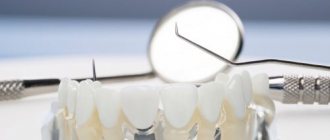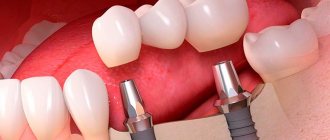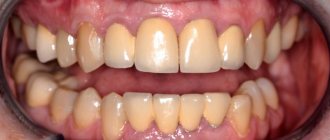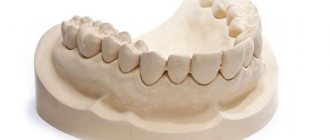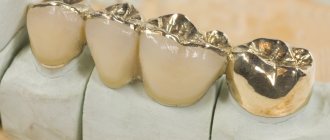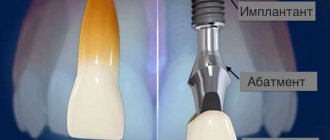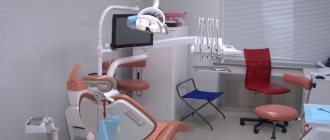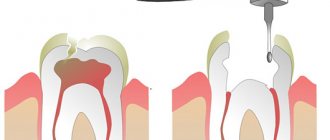Is it possible to restore teeth with implantation in one day?
A technique that allows you to quickly restore one or more missing teeth is called one-stage implantation and involves installing an implant and a temporary crown on it during just one appointment with a doctor. Moreover, the operation is performed transgingivally without making an incision in the gum and folding back its flap (dental implantation without an incision). It is worth mentioning one more technique, which is usually used in cases where a tooth destroyed as a result of injury or a long-term inflammatory process cannot be completely treated or restored with a crown or dental inlay. In such situations, which occur quite often, the tooth is removed, an implant is immediately installed in its place and it is loaded with a temporary crown, that is, a simultaneous implantation is performed.
Work results
Some of the latest results of implantation work. Click on the image to see the full before and after photos:
Result of dental implantation No. 23. Click on the image
Result of dental implantation No. 17. Click on the image
Result of dental implantation No. 9. Click on the image
Other results of work...
What are the advantages of one-stage implantation?
Firstly, with its help you can close the gap formed due to tooth loss with a reliable and aesthetic design and not be embarrassed about your smile. Secondly, a temporary dental crown immediately installed on the implant allows you to create an ideal gum contour and avoid the appearance of a very common defect during delayed implantation - black triangles - spaces between the artificial tooth and adjacent natural teeth not covered by soft tissue. And thirdly, one-stage implantation reduces treatment time by approximately half.
To attract clients, some clinics often call the one-stage method express implantation and promise to completely restore the patient’s tooth in one day. But you need to understand that during one appointment, the doctor can load the implant only with a temporary crown, and install a permanent one three to four months later. Loading an implant that is not yet fully stabilized in the bone with a fairly heavy permanent structure threatens, firstly, with its rejection, and secondly, with the occurrence of a rather dangerous defect. The fact is that after the operation the soft tissues are very inflamed and fit very tightly to the crown. After some time, the swelling subsides and a gap forms between the gum and the prosthesis, which is closed with a more suitable permanent crown. If you immediately install a permanent structure on the implant, the resulting gap will no longer be able to be closed. After some time, the gums will sink even more and expose the abutment, which will be very noticeable when you smile, and the bacteria accumulating on it will cause inflammation and, as a result, re-implantitis.
Postoperative period
Whether the implant will take root and how long it will last depends on the patient’s behavior during the recovery period and strict implementation of all recommendations. The main prohibitions concern:
- Hard, too hot and very cold food.
- Aggressive brushing of teeth, which can injure the intervention area.
- Visits to the bathhouse, sauna, swimming pool.
- Strong physical activity.
It is important to carefully monitor oral hygiene, use rinses, and be attentive to any changes. Regular visits for preventive examinations are required.
What is better: classic two-stage implantation or one-stage implantation?
It is, of course, best to restore the front teeth using a one-stage technique, but the presence of contraindications does not always allow it to be carried out. In such cases, we resort to a two-stage technique, which is also one of the most effective methods of prosthetics. Therefore, it is impossible to call any of the above methods the best. It is important to understand which one will be most acceptable and safe for the patient. However, let us outline all the advantages of one-stage implantation:
- the ability to complete the entire procedure in a short period of time;
- use of local anesthesia only;
- the ability to carry out installation, even with complete or partial absence of teeth;
- absence of invasive and painful surgical intervention;
- the possibility of performing the procedure even with a small amount of bone tissue;
- installation of an implant immediately after tooth extraction;
- the ability to perform chewing movements on the day of the procedure;
- relatively low cost.
Possible complications
After one-stage implantation, the following complications may occur:
- Swelling and pain at the surgery site.
- Peri-implantitis.
- Implant rejection.
Discomfort and some swelling in the area where the implant was implanted is normal and passes quickly. If the situation worsens, this is a reason to immediately consult a doctor. Peri-implantitis is inflammation of the tissue around the implant. If bone inflammation is not removed in time, it will lead to implant rejection and damage to surrounding tissues. If the implant becomes mobile, it probably has not taken root.
HISTORY OF THE IMMEDIATE LOAD IMPLANTATION METHOD
This implantation method originates at approximately the same time as the classical one, but due to the fact that the commercial wave picked up the classical protocol, it is more common these days. But the more people suffer from bone atrophy, as well as the inability to restore teeth in an acceptable short time, the faster new approaches are developed. In 2011, the European Open Dental Society (ODC) together with the Institute. Tramonte, dr. Tomasz Grotowski (follower of the basal implantation school created by Dr. Garbaccio) and other colleagues, adherents of the Immediate load technique, improved the structure and technology of implantation. Their developments formed the basis for the creation of the ROOTT implantation system by the Swiss company TRATE AG. Being a member of ODC and taking an active part in developments, the center became the first clinical base in Russia to use the new technique on an exclusive basis
Installation of ROOTT implants (Switzerland) using one-stage technology
Patented ROOTT implant system made in Switzerland. The rods are presented in the form of anatomical dental roots, designed for penetration into a narrow bone and with its minimum volume.
The main feature of such roots is that they penetrate into the deepest, hardest layers of bone. Also, when using ROOTT systems, permanent dentures can be installed a week or two after screwing in the rod.
- ROOTT Compressive - screw compression rods of one-piece design. They are embedded in the basal and cancellous layers of bone, can be used with a narrow ridge, and are screwed transgingivally.
- ROOTT Basal are screw basal-cortical implants, in which the main part is screwed into the deep layers of the bone. They are used for narrow ridges or bone deficiency and are suitable for one-stage implantation.
Thanks to a simple and atraumatic installation procedure, ROOTT dental implants take root well with a minimal rehabilitation period for the patient.
Computer diagnostics to eliminate risks
Performed on a high-precision dental tomograph Sirona Galileos (Germany)
- Assessment of bone tissue parameters, size and density to select an implant model
- Identification of anatomically important structures (nerves, vessels, maxillary sinus) to avoid their damage
- Virtual 3D surgery planning for error-free implantation
Lifetime Warranty
We have eliminated the risk of errors at every stage - from 3D diagnostics, surgery planning and the use of high-tech equipment to a complex of accelerated rehabilitation. Therefore, without fear, we provide a lifetime guarantee for implantation in the Dr.Levin LifeTime Warranty format .
Operations are performed only by experienced maxillofacial surgeons and implantologists who perform complex operations every day.
We work exclusively with premium Nobel Biocare implants, for which we issue warranty certificates.
In 2004, our clinic received the status of Nobel Biocare Center of Clinical Excellence in Eastern Europe. This means that over 10 years of work, the percentage of rejection of implants installed in our Center is less than 2%.
Mini implants
Mini-implants are miniature titanium pins with threads (similar to classic implants), only with a smaller diameter - from 1.8 to 2.4 mm. Most often, they are used to improve the fixation of removable dentures - in this case, the root part of the threaded mini-implants is screwed into the bone, and the part protruding above the gum serves to fix the removable denture.
Less commonly, mini-implants are used for fixed prosthetics with bridges of short length. For example, this is relevant for a narrow alveolar process of the lower jaw - if the patient is unwilling to undergo bone grafting to increase bone thickness. In orthodontics, these implants are used to create a stationary lever when moving teeth.
Important: if you are considering the option of removable prosthetics on mini-implants, then the most important thing you should pay attention to is that there are 2 systems for fixing removable dentures to mini-implants. Firstly, a fixation system using traditional ball-shaped abutments (Fig. 2-3). Secondly, the latest Locator® system, which uses equator-type abutments.
Advantages of mini implants:
- no need for bone grafting,
- low trauma and rapid tissue healing after surgery,
- fast terms of prosthetics,
- comfort – they allow you to achieve good fixation of a removable denture, as well as significantly reduce the size of its plastic base.
Below we will tell you about the features of the operation of installing mini-implants, as well as the stages of prosthetics on them with removable dentures, as well as fixed bridges. It should be noted that due to the lower cost and simpler installation, the cost of mini implants for the operation will be lower than the cost of installing classic implants.
Indications and contraindications
The technique is associated with certain risks, so it is not indicated for every patient. Although the list of contraindications is shorter than with the classic protocol. One-stage installation of implants cannot be performed on patients who have serious disorders of the endocrine system. It is contraindicated for patients who use drugs and abuse alcohol. Also relative contraindications are:
- Diabetes mellitus (conditional contraindication, that is, under certain conditions, implantation is possible).
- Serious disorders of the cardiovascular system.
- Kidney and liver failure.
If the parameters are normalized after the course of treatment, implants can be placed. The possibility of carrying out one-stage dental implantation, the price is determined individually after consultation with a doctor.

